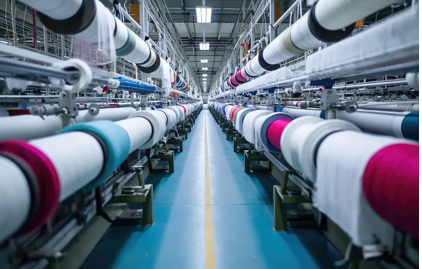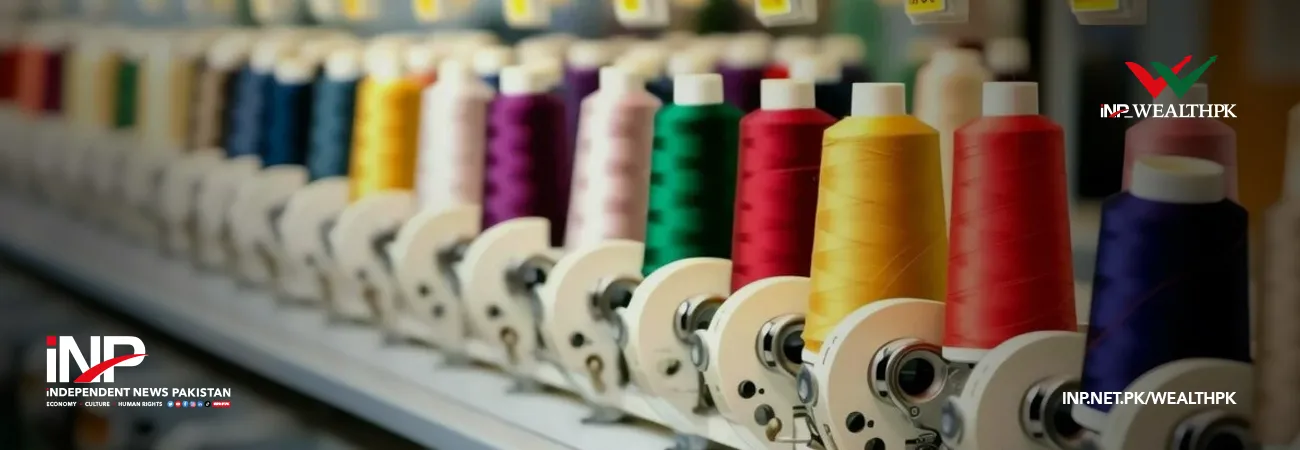INP-WealthPk
Hamza Ali
Pakistan’s textile industry, once a flourishing sector and foremost industrial employer as well as a significant source of foreign exchange, is nowadays on a downward trajectory due to the high input costs and an increasingly hostile policy environment, impacting its global competitiveness, reports WealthPK.

The manufacturing facilities are operating at constrained levels, with mass layoffs underway and export demands diminishing. The textile sector has long been regarded as the backbone of Pakistan’s economy, accounting for more than 60% of the total exports and employing millions across the value chain — from ginning and spinning to weaving, dyeing, and garment production.
However, a growing number of mills have recently reduced or ceased operations entirely, blaming it on the high input prices and an increasingly hostile policy environment. “Pakistan’s textile industry is on the verge of decline, as the soaring energy prices and high tariffs continue to erode its global competitiveness and threaten the export potential,” said Waleed Mumtaz Abbasi, Manager Cotton Sustainable Projects at the Rural Business Development Centre (RBDC), in an interview with WealthPK.
Figures depict a catastrophic scenario. The cost of electricity has surpassed Rs50/unit, while gas is still in short supply in many industrial zones. The textile manufacturing chain is highly cost-sensitive in Pakistan due to the high energy cost, which accounts for about 30–35% of the overall production expenses. The local manufacturers are at a price disadvantage when compared to the regional textile powerhouses like Bangladesh and India due to the much higher energy rates.
The burden increases due to the high import duties on raw materials and machinery, which are required for modernization and production sustainability. These duties make it difficult for even established businesses to modernize their premises or use energy-efficient technologies. Smaller textile plants, particularly SMEs, bear the brunt of this pressure. Many have already halted business, laid off employees, or defaulted on loan payments.
Muhammad Zakarya, Deputy Manager of Planning at Al Rahim Textile, emphasized the urgent need of intervention. “Pakistan’s textile industry stands at a critical crossroads; without urgent reforms to address the soaring energy costs and regional disparities, the country risks losing its export edge, millions of jobs, and long-term economic stability,” he said. Social, strategic, and economic challenges exist. The textile industry’s collapse would devastate millions of jobs.
If the situation is not addressed quickly, the cotton-growing villages and urban centres with textile clusters, like Faisalabad, Lahore, and Karachi, might suffer severe unemployment and social instability. A comparison with regional competitors shows an increasingly uneven playing field. Bangladesh provides subsidized energy to the export-oriented sectors and maintains policy continuity, helping firms plan.
India supports textile centres with state-level incentives, energy rebates, and infrastructure. Trade agreements, improved export facilitation, and lower industrial utility costs assist Vietnam, another growing textile industry player. In contrast, the textile exporters in Pakistan encounter unpredictable policy changes, postponed refunds of sales tax, Drawback of Local Taxes and Levies (DLTL), as well as the absence of long-term incentives.
Lack of a consistent energy pricing policy across regions intensifies disparities in the country, resulting in higher production costs for exporters in certain provinces compared to others. The industry leaders advocate immediate government intervention by presenting specific policy recommendations: aligning energy tariffs with regional averages, eliminating import duties on raw materials and energy-efficient machinery, ensuring prompt tax refund disbursement, and facilitating subsidized financing for renewable energy transitions, such as solar and biomass.
Analysts caution that failure to act may result in enduring repercussions. Pakistan faces the threat of losing its global market share to competitors that are more cost-efficient and reliable. Regaining the trust of international buyers, once lost, may require years, if not decades. Potential risks associated with deindustrialization are also present. A sustained crisis may push the manufacturing sector into informal and less efficient areas of economy, potentially undoing decades of industrial advancement.
Furthermore, a decline in textile exports would considerably affect Pakistan’s foreign exchange reserves, worsening the trade deficit and increasing pressure on the rupee. The textile sector is a critical component of Pakistan’s economic framework. Preservation is now essential rather than optional. As Zakarya noted, “urgent reforms” are the only way forward. Without them, the sector may not survive the next round of global competition or even the next fiscal year.
Credit: INP-WealthPk













